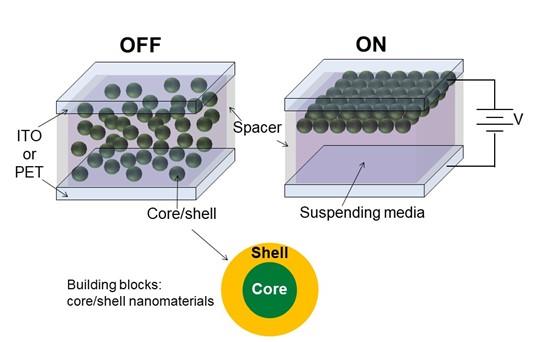The transmission and absorption characteristics of smart optical materials can change in response to different optical or electrical inputs. These materials can be found in a variety of markets ranging from scientific research tools to consumer goods. Windows whose transparency and color tint can be changed on demand have value in many fields ranging from buildings to vehicles to scientific research. Materials called photonic crystals (PCs) have the capability of being engineered into smart optics. In the past decade, strong light-matter interactions in luminescent nanocrystals have been demonstrated when combined with PC structures.
Typically, the building blocks for PC structures are non-luminescent materials such as SiO2, TiO2, and polystyrene. Colloidal PCs designed with luminescent nanomaterials are still in early stages of development, but they have great potential as smart optical materials. The luminescence output of these less well studied materials can be dramatically changed by altering the structural parameters (e.g., particle size, size distribution).
Research groups have endeavored to incorporate smart optical materials into displays, solar cells and sensors. So far, smart optical material research has been primarily focused on light reflection characteristics for display applications. For more sophisticated applications, there is a need for novel PCs with constituent materials that can enable dynamic tuning of not only reflection features, but also transmission and luminescence properties in response to external stimuli such as electric signals.
LLNL inventors have shown that the optical material properties (transmission, reflectance, color) of an assembled device can be dynamically tunable using innovative core-shell nanomaterials and a structured composite crystal/colloid design. These smart optical materials are assembled from nanosized constituents that have a native surface charge. The nanoparticles can be manipulated by an applied electric field, which subsequently influences the overall structure of particle assemblies. This process is called electrophoretic deposition (EPD), which after proper selecting of material and optimizing for particle size and other structural parameters, can be successfully used to dynamically tune the optical properties of the photonic crystal device. LLNL researchers were able to demonstrate that in response to electric stimuli, the crystallinity of the particle assemblies can be altered, resulting in a distinct appearance change of their smart optical material from opaque to transparent.
- Scalability of uniform size non-luminescent or luminescent colloidal nanocrystals
- Design choice of core and shell material combination to optimize the desired characteristic(s)
- A broad range of core/shell material combinations are possible giving significant flexibility to the technology leading to a wide range of applications.
- Rapid synthesis scaling
Optical sensors, meta-materials, smart windows
Current stage of technology development: TRL 3
LLNL has patent(s) on this invention.
U.S. Patent No. 10,732,480 Novel Transparency And Color Tunable Electro-Optical Device Using Colloidal Core/Shell Nanoparticles issued 8/4/2020.


